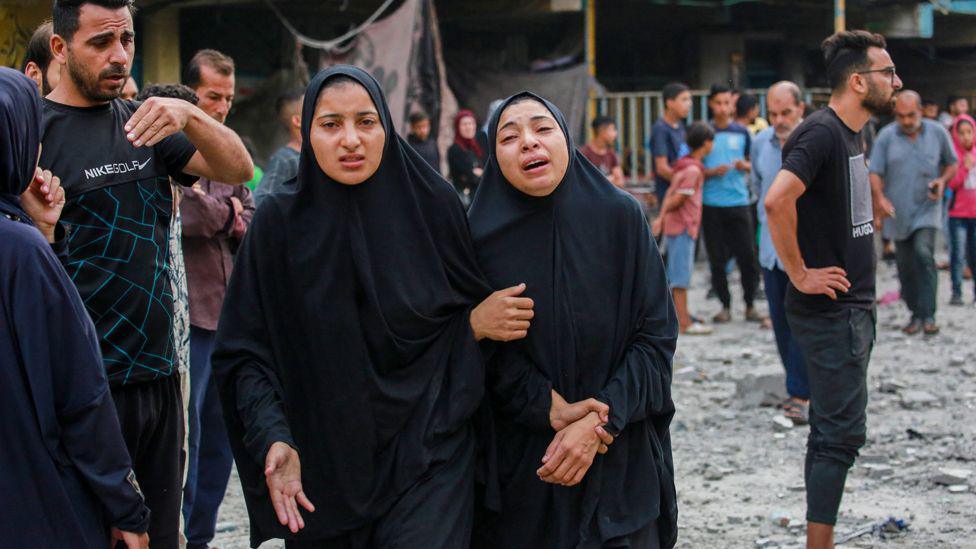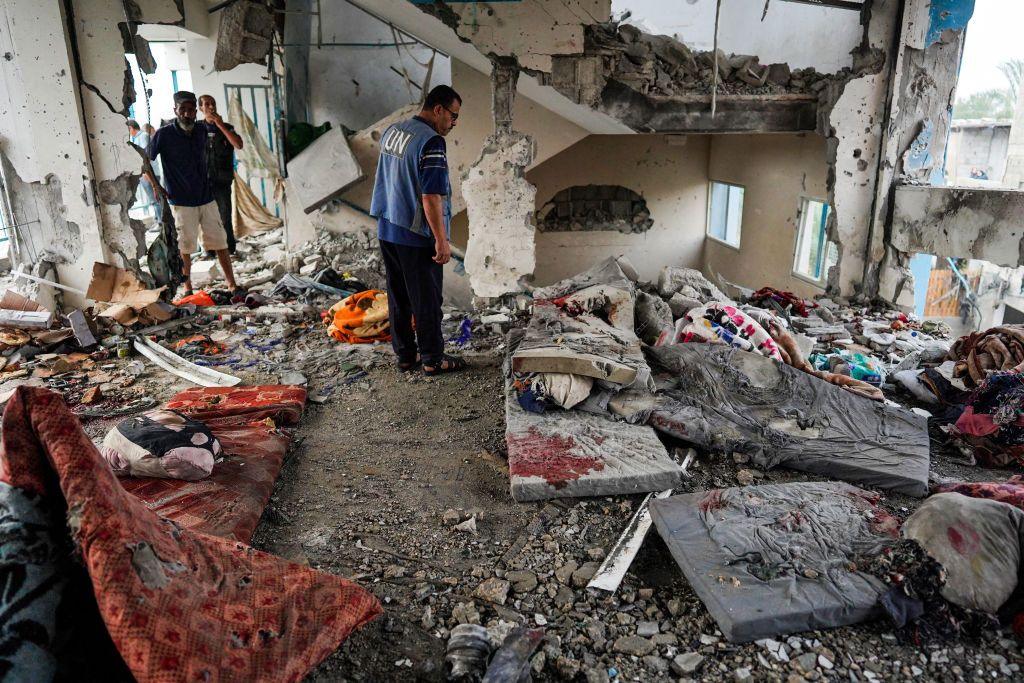Israeli strike on UN school in Gaza reportedly kills at least 35

Witnesses and local journalists said missiles hit classrooms on upper floors of the UN school
- Published
An Israeli air strike on a UN school packed with displaced Palestinians in central Gaza has reportedly killed at least 35 people.
Local journalists told the BBC that a warplane fired two missiles at classrooms on the top floor of the school in the urban Nuseirat refugee camp. Videos showed the destruction and a number of bodies.
Israel’s military said it had “conducted a precise strike on a Hamas compound” in the school and killed many of the 20 to 30 fighters it believed were inside.
Gaza’s Hamas-run Government Media Office denied the claim and accused Israel of carrying out a “horrific massacre”.
The US has called on Israel to be "fully transparent" in making information about the strike public.
The head of the UN agency for Palestinian refugees (Unrwa), which runs the school, described the incident as "horrific" and said the claim that armed groups might have been inside a shelter was "shocking" but could not be confirmed.
Dead and wounded people were rushed to the al-Aqsa Martyrs’ Hospital, in the nearby town of Deir al-Balah, which has been overwhelmed since the Israeli military began a new ground operation against Hamas in central Gaza this week.
Israel launches new military operation in central Gaza
- Published5 June 2024
Mass graves and body bags: al-Shifa hospital after Israel withdrew its forces
- Published5 June 2024
The BBC is working to verify the reports about the strike in Nuseirat camp.
Local journalists and residents said it took place in the early hours of Thursday at al-Sardi school, which is in a south-eastern area of the densely-populated, decades-old camp, where Unrwa provides services.
Unrwa said 6,000 displaced people were sheltering in the school complex at the time. Many schools and other UN facilities have been used as shelters by the 1.7 million people who have fled their homes during the war, which has lasted almost eight months.
Videos shared on social media showed the destruction of several classrooms in one of the school's buildings, as well as bodies wrapped in white shrouds and blankets.
“I was asleep when the incident occurred. Suddenly, we heard a loud explosion and shattered glass and debris from the building fell on us,” Udai Abu Elias, a man who was living at the school, told BBC Arabic's Gaza Today programme.
“Smoke filled the air, and I couldn't see anything. I didn't expect to make it out alive. I heard someone calling for survivors to come out from under the rubble. I struggled to see as I stumbled over the bodies of the martyrs.”
He added: “The situation has become extremely difficult, especially for children and the elderly. Everyone is a target. The blood of the martyrs has not yet dried; it stains the stairs, walls, and bedding."
Another man, Jabr, said he “woke up to the sight of bodies and [human] remains everywhere”, while a third who asked not to be named said the casualties included "elderly people, young individuals, and children".

Residents initially said that more than 20 people were killed in the attack.
Later, an official at al-Aqsa hospital told a freelance journalist working for the BBC that it had received 40 bodies from the school.
Gaza’s Hamas-run health ministry said 40 people were killed, including 14 children and nine women, and 74 others were injured. The same death toll was given by the director of the Hamas-run Government Media Office, Ismail al-Thawabta.
Unwa's commissioner general, Philippe Lazzarini, said in a statement on X, formerly Twitter, that at least 35 people were killed and many more injured. The agency’s director of communications, Juliette Touma, told the BBC that "the figures are coming from our own Unrwa colleagues on the ground".
The BBC has been reviewing videos and has not yet seen conclusive evidence of civilian casualties at the scene of the strike. However, there is footage showing child casualties at al-Aqsa hospital.
US State Department spokesperson Matt Miller urged Israel to be transparent over the strike.
""The government of Israel has said that they are going to release more information about this strike, including the names of those who died in it. We expect them to be fully transparent in making that information public," he said.
In a statement, the Israel Defense Forces (IDF) said jets had conducted a "precise strike on a Hamas compound embedded inside" the school. An annotated aerial photograph highlighted classrooms on two upper floors of the building, which the IDF said were the “locations of the terrorists”.
The IDF said members of Hamas and Palestinian Islamic Jihad who took part in the 7 October attack on southern Israel, when around 1,200 people were killed and 251 others were taken hostage, had been operating in the building.
“Before the strike, a number of steps were taken to reduce the risk of harming uninvolved civilians during the strike, including conducting aerial surveillance, and additional intelligence information,” it added.

Later, IDF spokesman Lt Col Peter Lerner told reporters that between 20 and 30 fighters had been using the school to plan and carry out attacks, and that many of them were killed in the strike. "I'm not aware of any civilian casualties and I'd be very, very cautious of accepting anything that Hamas puts out," he added.
He also said the IDF had called off the attack twice in order to limit civilian casualties and accused Hamas and Palestinian Islamic Jihad of deliberately using UN facilities as operational bases.
Mr Thawabta rejected the IDF’s claims, saying: “The occupation uses lying to the public opinion through false fabricated stories to justify the brutal crime it conducted against dozens of displaced people.”
Mr Lazzarini said the school was hit “without prior warning” to his agency or the people sheltering there.
“Claims that armed groups may have been inside the shelter are shocking. We are however unable to verify these claims,” he added.
“Attacking, targeting or using UN buildings for military purposes are a blatant disregard of international humanitarian law. UN staff, premises and operations must be protected at all times.”
Mr Lazzarini complained that more than 180 Unrwa buildings had been hit since the war began despite their co-ordinates being shared with parties to the conflict, and that more than 450 displaced people had been killed as a result.
At least 36,650 people have been killed in Gaza since Israel launched a military campaign in response to the 7 October attack, according to the territory's health ministry, whose figures do not differentiate between civilians and combatants.
Medics also told AFP and Palestinian news agency Wafa that another pre-dawn strike on Thursday killed six people at a house in Nuseirat camp.
The IDF meanwhile said troops had located underground tunnel shafts and weapons in eastern areas of Bureij refugee camp - just west of Nuseirat - and eastern Deir al-Balah, a day after it said they had taken "operational control" there.
Residents reported intense bombardment in the areas on Wednesday, while Médecins Sans Frontières said at least 70 bodies - the majority women and children - had been brought to al-Aqsa hospital over the previous 24 hours.
The IDF also said on Thursday that troops and aircraft had killed three suspects who had approached the Gaza-Israel border fence in the Rafah area, and that an Israeli soldier had been killed in battle in southern Gaza.

UN schools across Gaza have been used as shelters for displaced people throughout the war
Last month, there was global outrage after an Israeli air strike, which the IDF said targeted two senior Hamas officials, and a resulting fire reportedly killed dozens of Palestinians at a tented camp for displaced people near a Unrwa logistics base in the southern city of Rafah.
The IDF said the loss of life was “tragic” and that it was investigating the possibility that ammunition stored by Hamas could have caused a secondary explosion.
That incident prompted mediators to revive their efforts to broker a ceasefire and hostage release deal between Israel and Hamas.
US President Joe Biden outlined what he described as an Israeli proposal that had been presented to Hamas.
The first phase of the plan would last six weeks and include a temporary truce that would see the release of some of the hostages still being held in Gaza in return for Palestinians from Israeli jails. The second phase would include a permanent cessation of hostilities.
On Thursday, the US, UK and 16 other countries with citizens among the hostages issued a joint statement calling on the leaders of Israel and Hamas “to make whatever final compromises are necessary to close this deal and bring relief to the families of our hostages”.
Hamas political leader Ismail Haniyeh said on Wednesday that the group would deal "seriously and positively" with a proposal based on an end to the war and a full Israeli withdrawal from Gaza.
Israel's Prime Minister Benjamin Netanyahu has insisted he will not agree to a permanent ceasefire before Hamas is defeated and the hostages are released. On Wednesday, he declared the country was “striving for total victory”.
Additional reporting by George Wright in London